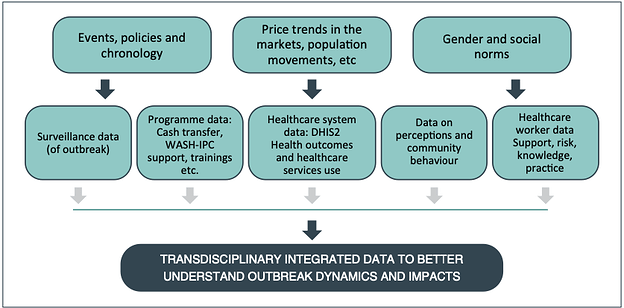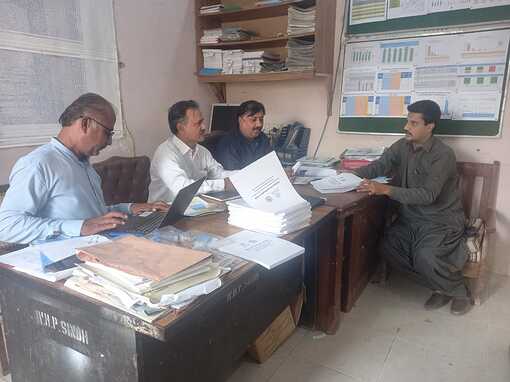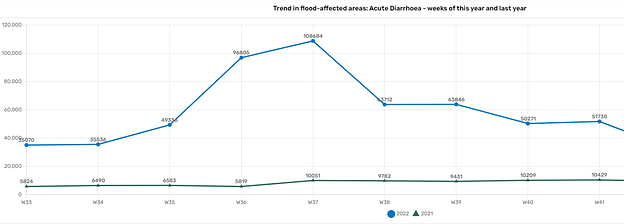Pakistan is prone to periodic flooding especially during the monsoon season between April and September when up to three quarters of the country’s annual rainfall occurs. This year, the Minister for Climate Change reported that the country received 87% more rainfall than the annual average. Since mid-June 2022, torrential rains have caused catastrophic floods in Pakistan resulting in the deaths of about 1,700 people and the displacement of an additional 8 million. With a third of the country still flooded, healthcare concerns, particularly water-borne diseases, have continued to mount. Between July and October 2022, about 540,000 malaria cases have been reported. Also, diarrheal diseases, dengue fever and measles outbreaks have also occurred in different parts of the country.
“It could take six months for flood waters to recede in the hardest-hit areas” - UNHCR
Tackling these public healthcare challenges requires concerted efforts by multidisciplinary teams, sharing information in seamless collaboration. Consequently, the concept of Integrated Outbreak Analytics (IOA) which promotes cooperation through joint research, data collection, analytics and interpretation, was adopted. This concept is further strengthened by the DHIS2-based HMIS already being used in Pakistan.
Because of the health emergency, 19 key water-related diseases (water-borne, water-washed, and water-based) have been monitored closely in two of the most affected provinces in the country - Balochistan and Sindh. These diseases are tracked using the Integrated Disease Surveillance and Reporting (IDSR) system built in DHIS2. In the last quarter of 2021, the Pakistani Ministry of National Health Services, Regulation and Coordination (MoNHSRC) conducted a review of the IDSR with the support of the CDC and HISP groups. The review, which covered system configuration, server hosting arrangement and comparisons with WHO standard based surveillance packages, has helped the MoNHSRC better utilize the DHIS2-based IDSR system in response to the floods.
Routine surveillance data for 33 priority diseases is collected weekly in all 54 districts in the country using the IDSR system and supervised by the Pakistani National Institute of Health (NIH) which is hosted at National Data Center of NIH and being managed by TECH department of NIH. Likewise, emergency data required for effective responses to the floods are collected in DHIS2 in parallel to the routine data and analyzed in the same integrated instance for better monitoring. The current routine workflow is paper-based up to the district level, where the data is digitized and reported in the national HMIS.
Based on the principles of IOA, multiple groups, operating at different layers, collaborate by sharing data to drive relief activities and infrastructure repairs. At the district level, specialists including epidemiologists, disease notification officers among others, interface with the healthcare facilities to collect data on both routine and priority water-related diseases. These data are passed on to the provincial flood response centres where preliminary analyses inform limited province and district level interventions. The healthcare data, in combination with others relating to infrastructure, are passed up to the National Flood Response and Coordination Center (NFRCC) and the National Institute of Health who jointly manage the national response and direct resource allocation. At the national level, the joint coordination team is supported by international development organizations including USAID and CDC. The CDC has engaged the HISP Pakistan to strengthen data collection efforts and use at the provincial level thereby ensuring good quality data for intervention management at all levels. On the other hand, USAID, through the John Snow Inc (JSI), uses the collected data to guide its interventions in infrastructure repairs, particularly, healthcare infrastructure required to sustain adequate emergency responses.
As the health emergency continues, the plan for the country is to pave the way for the digitization of surveillance data from the lowest administrative level (health facilities and ad hoc internally displaced camps) in order to enter the data directly in DHIS2 via mobile tools (Android app) or SMS via an SMS gateway set up by HISP Pakistan in coordination with TECH Department of NIH. While the analog-to-digital conversion proposal is still being evaluated, the nature and scale of the health emergency has already led to increasing the tempo of the reporting period from weekly to daily for the 13 priority diseases. This increased frequency of reporting has helped the MoNHSRC monitor these diseases more closely, by generating more granular, up-to-date data that facilitates faster responses to outbreaks and other associated humanitarian challenges.
In the picture: Data clerks in the Badin district of the Sindh province
Although the rapid shift of reporting periods and diseases under focus has had some effects on data quality and completeness of reports, the gaps identified are being addressed with extra supervision and training efforts in order to sustain the collection of high quality data. The daily surveillance data is directly synched in real time to the DHIS2 dashboard accessed in the Prime Minister’s office to aid timely evidence-based decision making and prompt interventions where necessary.
Due to a lack of historical data on the 13 priority water-associated diseases during similar floods in the past, analysis of current surveillance data is done in contrast with past routine data available in the IDSR repository. The data is subsequently visualized in an integrated public DHIS2 dashboard developed by HISP Pakistan and HISP Centre (UiO) in strong collaboration with TECH department of NIH, and triangulated on a weekly basis to obtain a clear picture of the impact of the floods on the health status of the population as well as the degree of disruption of the health infrastructures and services.
Screenshot taken from the public dashboard
Moreover, daily bulletins are created and shared with the National Flood Response & Coordination Center to provide the most up-to-date snapshot of the situational equation. With the help of DHIS2, the optimized data flow has resulted in more investments to the response activities such as creation of testing facilities and new IDP camps. Medical and emergency logistics systems have also utilized the data to streamline the supply of vaccines, drugs, water, sanitation and hygiene needs to homes and camps. Finally, good data visualization enhanced by the DHIS2 IDSR has enabled responders to give more immediate attention to the most at-risk areas by relying on preset alerts and observing the progression of peaks in the visualized data.


